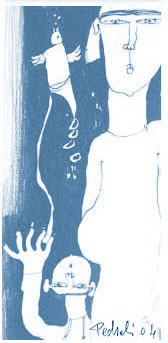Objective: To verify the viability of isolated primordial
follicles to different propylene glycol (PROH) and glycerol (GLY)
concentrations before and after cryopreservation.
Design: Isolated primordial follicles were stained with trypan
blue to evaluate the effect of different PROH and GLY concentrations
before and after cryopreservation. Setting: Laboratorio Renzo Giuliani,
University of Florence, Italy. Patient(s): Thirty- to forty-day-old
lambs. Intervention(s): Isolation of primordial follicles with subsequent
exposure to cryoprotectant and freezing. Main Outcome Measure(s):
Histologic structure and follicular mortality. Result(s):
After the isolation procedure (control), the mean number of live primordial
follicles/mL was 2,688 and 4,452 in the GLY and PROH groups, respectively.
When GLY was used, the number of live follicles before cryopreservation
was 820, 756, 640, 524, 564, and 460 follicles/mL with concentrations
of 0, 0.5, 1.0, 1.5, 2.0, and 2.5 mol/L, respectively. After cryopreservation,
this number decreased to 0, 12, 36, 100, 84, and 68 follicles/mL,
respectively, with the same concentrations. When PROH was used, the
number of live follicles before cryopreservation was 4,216, 3,880,
3,560, 1,812, 704, and 568 follicles/mL with concentra¬tions of
0, 0.5, 1.0, 1.5, 2.0, and 2.5 mol/L, respectively. After cryopreservation,
this number decreased to 0, 116, 336, 472, 360, and 244 follicles/mL,
respectively, with the same concentrations.
Conclusion(s): Both cryoprotectants were shown to preserve
isolated primordial follicles after cryo¬preservation.
|

